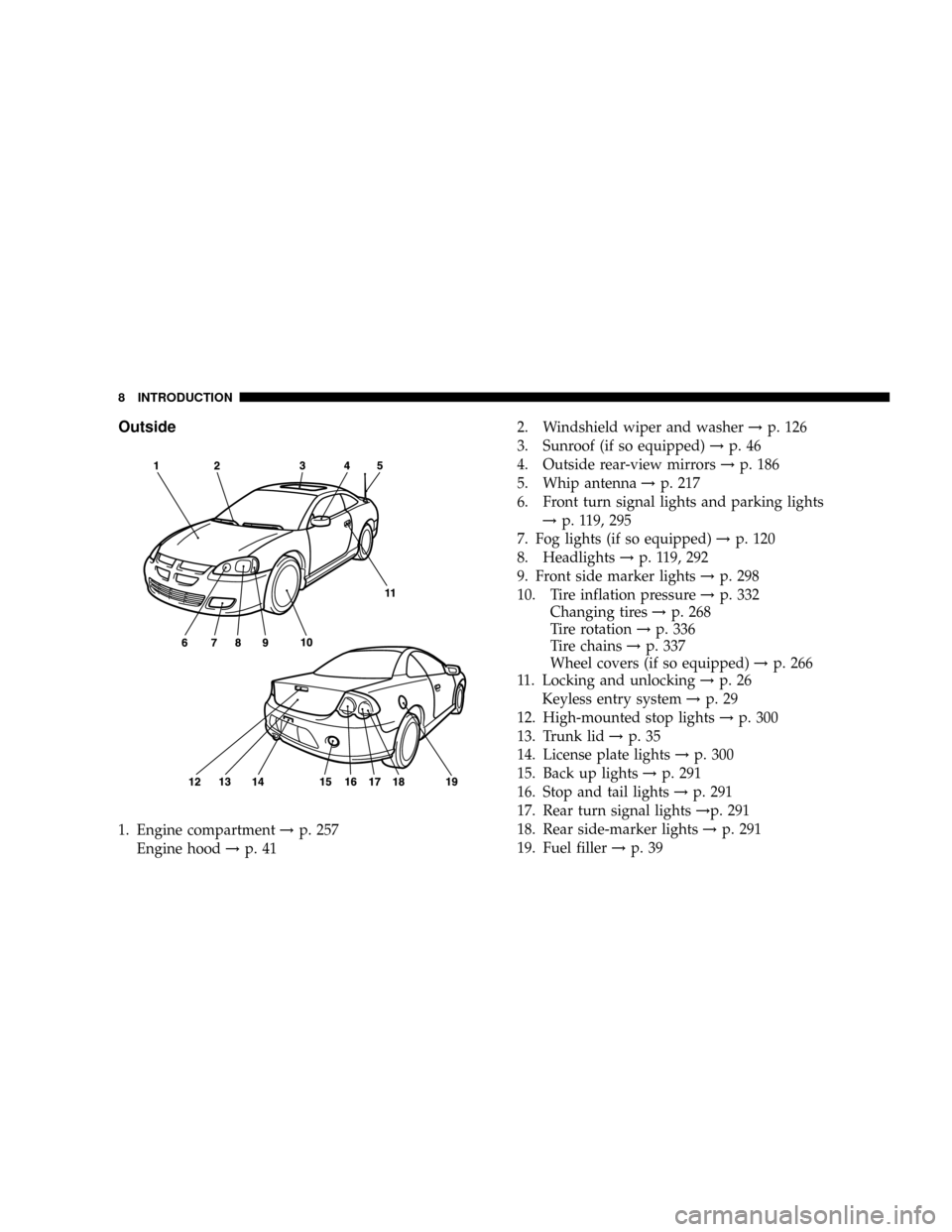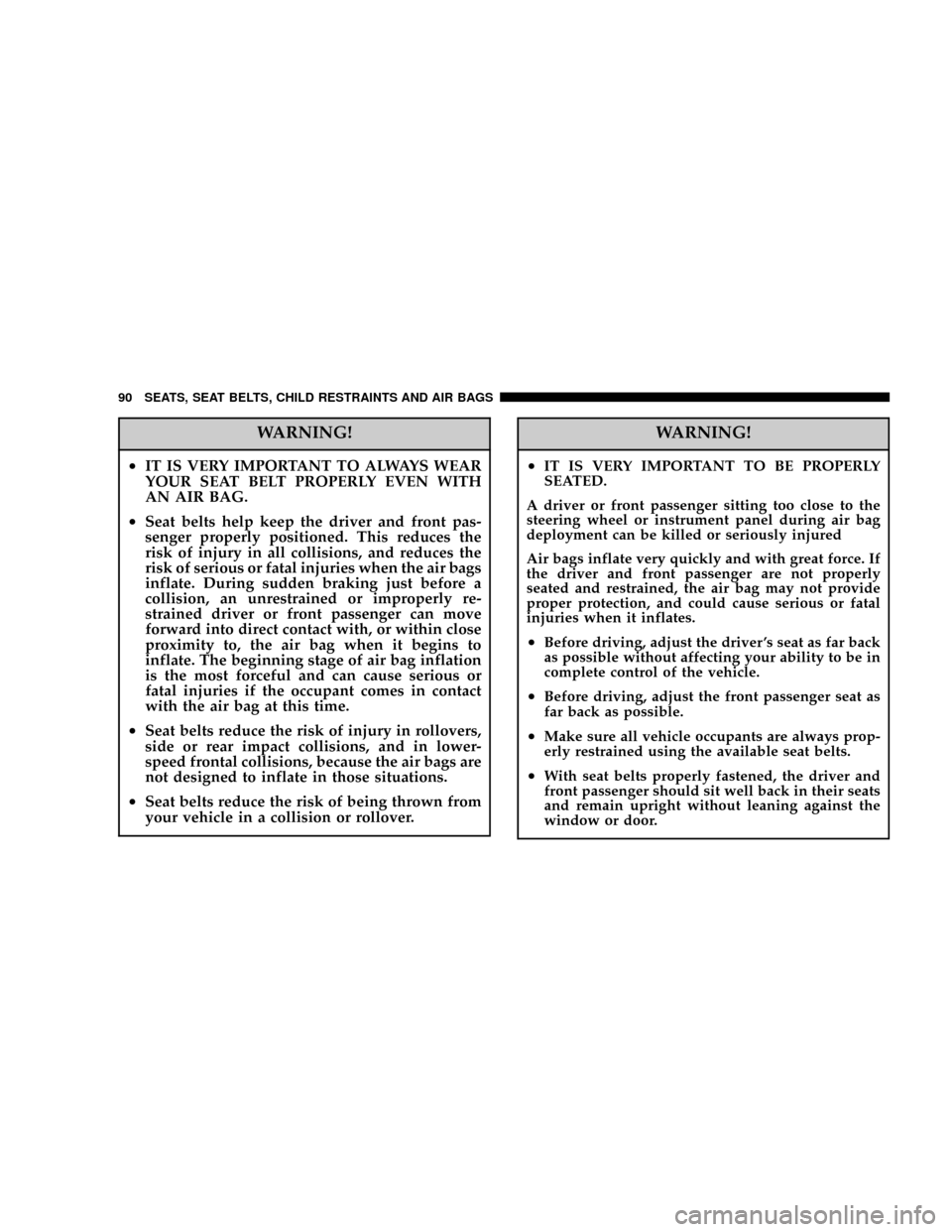wheel DODGE STRATUS COUPE 2004 2.G Owners Manual
[x] Cancel search | Manufacturer: DODGE, Model Year: 2004, Model line: STRATUS COUPE, Model: DODGE STRATUS COUPE 2004 2.GPages: 388, PDF Size: 2.28 MB
Page 8 of 388

Outside
1. Engine compartment!p. 257
Engine hood!p. 412. Windshield wiper and washer!p. 126
3. Sunroof (if so equipped)!p. 46
4. Outside rear-view mirrors!p. 186
5. Whip antenna!p. 217
6. Front turn signal lights and parking lights
!p. 119, 295
7. Fog lights (if so equipped)!p. 120
8. Headlights!p. 119, 292
9. Front side marker lights!p. 298
10. Tire inflation pressure!p. 332
Changing tires!p. 268
Tire rotation!p. 336
Tire chains!p. 337
Wheel covers (if so equipped)!p. 266
11. Locking and unlocking!p. 26
Keyless entry system!p. 29
12. High-mounted stop lights!p. 300
13. Trunk lid!p. 35
14. License plate lights!p. 300
15. Back up lights!p. 291
16. Stop and tail lights!p. 291
17. Rear turn signal lights!p. 291
18. Rear side-marker lights!p. 291
19. Fuel filler!p. 39
8 INTRODUCTION
Page 16 of 388

If this problem occurs¼
Problem Do this Ref. Page
Cannot turn the key
(1)ªLOCKº to ªACCº
Turn the key while slightly turning the steering wheel
right and left.
(2)ºACCº to ªLOCKº
Vehicle with automatic transaxle
Check the position of gear selector lever.
The key cannot be removed unless the gear selector
lever is set to the ªPº (PARK) position.
Vehicle with manual transaxle
Place the key at the ``ACC'' position. Push the key in
and turn it.P. 149
Cannot shift the gear selector lever
from the ªPº (PARK) positionShift the gear selector lever while depressing the brake
pedal. Check if the ignition key is in the ªONº position.P. 152, 157
The windows are fogged up.
1.Set the heater/air conditioning mode selection dial to
the ªºorªº position.
2.Turn on the blower.P. 242
16 INTRODUCTION
Page 18 of 388

If this problem occurs¼
Problem Do this Ref. page
The vehicle is stuck in sand, mud, or
snow.1. Carefully rock the vehicle by shifting the transmission
from low to reverse.
WARNING
1.When attempting to rock your vehicle out of a stuck
position, be sure that no one is near the vehicle. The
rocking motion may cause the vehicle to suddenly lurch
forward or backward, and injure bystanders.
2.Avoid racing the engine or spinning the wheels.
Prolonged efforts to free a stuck vehicle may result in
overheating and transaxle failure.
If the vehicle remains stuck after several rocking
attempts, have a towing service pull the vehicle out.P. 261
The brakes are not functioning
properly after crossing a puddle or
stream.Dry out the brakes by driving slowly while lightly
depressing the brake pedal.Ð
18 INTRODUCTION
Page 57 of 388

Your vehicle has seat belts and other features that help
protect you and your passengers in an accident.
Seat belts are the most important safety device. When
worn properly, seat belts can reduce the chance of serious
injury or death in various types of crashes. For added
protection during a severe frontal collision, your vehicle
has a Supplemental Restraint System (SRS) with air bags
for the driver and front seat passenger. The seats, head
restraints, and door locks also are safety equipment,
which must be used correctly.
Always check the following before you drive:
7. Everyone in the vehicle is properly wearing their seat
belt.
8. Infants and small children are properly secured in
appropriate child restraints in the rear seat.
9. All doors are closed and locked.
10. Seat backs are fully upright, with head restraints
properly adjusted.No safety equipment can prevent all injuries or deaths
that can occur in severe collisions, but by making sure all
your passengers follow the instructions in this manual,
you can help reduce the risk of injury.
FRONT SEATS
Adjust the driver's seat as far back as possible to a
position that enables you to fully apply the pedals, easily
control the steering wheel, safely operate the vehicle and
also gives you a clear frontal view.
G21A0680
SEATS, SEAT BELTS, CHILD RESTRAINTS AND AIR BAGS 57
3
Page 58 of 388

WARNING!
²Do not attempt to adjust the seat while driving.
This can be dangerous.
²After adjusting the seat, make sure that the seat is
securely locked into position.
²Be sure to have the seat adjusted by an adult. If it
is adjusted by a child, the seat may not be prop-
erly locked into position.
WARNING!
²In order to reduce risk of serious or fatal injury in
a collision, including from a deploying front pas-
senger air bag, all front seat passengers should
move the front passenger seat as far back as
possible, all children 12 years old and under
should ride restrained in the rear seat, and all
children in rear-facing child restraints must ride
in the rear seat.
²In order to reduce risk of serious or fatal injury in
an accident, including from a deploying driver 's
side air bag, the driver should move the driver's
seat as far back as possible, while still maintain-
ing good visibility and good control of the steer-
ing wheel, accelerator and brake pedals.
NOTE: On vehicles with a power seat, to prevent the
battery from running down, operate the power seat with
the engine in operation.
58 SEATS, SEAT BELTS, CHILD RESTRAINTS AND AIR BAGS
Page 68 of 388

SEAT BELTS
Seat belts are installed in your vehicle for the protection
of the driver and passengers.
Always use the seat belts. In an accident, injury to the
driver and passengers may be reduced if the seat belts are
properly used.
NOTE: Legislation in your state may require seat belt
usage; however, even if it is not required seat belts should
always be used.
WARNING!
²Lock all doors before driving to reduce the risk of
injury or ejection in a collision.
²Seat belts should always be worn by every adult who
drives or rides in this vehicle, and by all children
who are large enough to wear seat belts properly.
²Never use one seat belt for more than one occupant.
²Never carry more people in the vehicle than there
are seat belts.
²Always adjust the belt for a snug fit.
²Always route the shoulder belt over your shoulder
and across your chest. Never put it behind you or
under your arm.
²Always wear the lap belt as low as possible across
your hips, not around your waist.
²To reduce the risk of serious or fatal injury in a
collision, including from a deploying driver air
bag, the driver should adjust the driver's seat to
the rear most position that still allows good vis-
ibility and good control of the steering wheel, the
brake, accelerator, and vehicle controls.
68 SEATS, SEAT BELTS, CHILD RESTRAINTS AND AIR BAGS
Page 70 of 388

UNIBELT instructions
1. Get in the vehicle and sit in a normal correct posture.
To reduce the risk of severe or fatal injury caused by an
inflating air bag, adjust the driver's seat to the rear most
position that still allows you to fully apply the pedals,
easily control the steering wheel and safely operate the
vehicle. The front passenger should also adjust their seat
as far back as possible. Refer to ªSupplemental Restraint
System (SRS) - air bagº on page 89.All vehicle occupant's should sit and remain seated all
the way back in their seat with their back resting straight
against the upright seat back.
WARNING!
To minimize the risk of personal injury in the event
of a collision or sudden stop, both the driver and
passenger seatbacks should always be in a nearly
upright position while the vehicle is in motion.
The protection provided by the seat belts may be
reduced significantly when the seatback is reclined.
There is greater risk that the driver or the passenger
will slide under the belt and be seriously injured
when the seatback is reclined.
G28A0210
70 SEATS, SEAT BELTS, CHILD RESTRAINTS AND AIR BAGS
Page 90 of 388

WARNING!
²IT IS VERY IMPORTANT TO ALWAYS WEAR
YOUR SEAT BELT PROPERLY EVEN WITH
AN AIR BAG.
²Seat belts help keep the driver and front pas-
senger properly positioned. This reduces the
risk of injury in all collisions, and reduces the
risk of serious or fatal injuries when the air bags
inflate. During sudden braking just before a
collision, an unrestrained or improperly re-
strained driver or front passenger can move
forward into direct contact with, or within close
proximity to, the air bag when it begins to
inflate. The beginning stage of air bag inflation
is the most forceful and can cause serious or
fatal injuries if the occupant comes in contact
with the air bag at this time.
²Seat belts reduce the risk of injury in rollovers,
side or rear impact collisions, and in lower-
speed frontal collisions, because the air bags are
not designed to inflate in those situations.
²Seat belts reduce the risk of being thrown from
your vehicle in a collision or rollover.
WARNING!
²IT IS VERY IMPORTANT TO BE PROPERLY
SEATED.
A driver or front passenger sitting too close to the
steering wheel or instrument panel during air bag
deployment can be killed or seriously injured
Air bags inflate very quickly and with great force. If
the driver and front passenger are not properly
seated and restrained, the air bag may not provide
proper protection, and could cause serious or fatal
injuries when it inflates.
²Before driving, adjust the driver 's seat as far back
as possible without affecting your ability to be in
complete control of the vehicle.
²Before driving, adjust the front passenger seat as
far back as possible.
²Make sure all vehicle occupants are always prop-
erly restrained using the available seat belts.
²With seat belts properly fastened, the driver and
front passenger should sit well back in their seats
and remain upright without leaning against the
window or door.
90 SEATS, SEAT BELTS, CHILD RESTRAINTS AND AIR BAGS
Page 91 of 388

WARNING!
²Do not sit on the edge of the seat or lean your head
or chest close to the steering wheel or instrument
panel. Do not put your feet or legs on or against
the instrument panel.
²Seat all infants and children 12 years of age and
under in the rear seat properly restrained using an
appropriate child restraint system.
WARNING!
²Infants and small children should never ride
unrestrained, or lean against the instrument
panel. They should never ride held in your arms
or on your lap. They could be seriously injured or
killed in a collision, especially when the air bag
inflates. Children should be properly seated in
the rear seat in an appropriate child restraint
system. Refer to ``Child Restraints'' on page 76.
G28G1570G28G1760
SEATS, SEAT BELTS, CHILD RESTRAINTS AND AIR BAGS 91
3
Page 96 of 388

WARNING!
²Do not attach anything to the steering wheel's
padded cover, such as trim material, badges, etc.
These could strike and injure an occupant if the
air bag inflates.
WARNING!
²Do not set anything on, or attach anything to, the
instrument panel above the glove compartment. Such
items could strike and injure an occupant if the air
bag inflates.
²Do not mount or locate any aftermarket equipment
on or behind the knee bolsters.
²Do not attach accessories to, or put them in front of,
the windshield. They could restrict the air bag infla-
tion, or strike and injure an occupant, when the air
bag inflates.
²Do not put packages, pets or other objects between the
air bags and either the driver or the front passenger.
This could affect air bag performance, or could cause
severe or even fatal injury when the air bag inflates.
²Right after air bag inflation, several parts of the air
bag system will be hot. Do not touch them. You could
be burned.
²The air bag system is designed to work only once.
After the air bags deploy, they will not work again.
They must promptly be replaced and the entire air
bag system inspected by an authorized dealer.
96 SEATS, SEAT BELTS, CHILD RESTRAINTS AND AIR BAGS